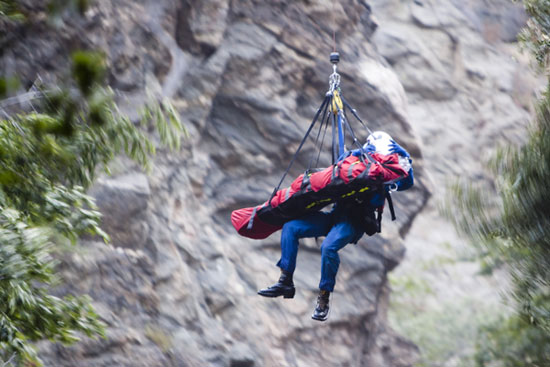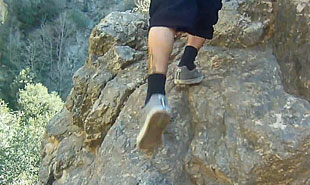The path more travelled
July 24, 2014
People are increasingly hitting the dusty trails and wilderness areas of the Santa Monica Mountains these days.
During the first six months of this year, the National Parks Service recorded 547,243 visits to the area—146,700 more than in the same period last year, a whopping 37% increase.
George Watland, Angeles Chapter director of the Sierra Club, said that kind of attendance surge is great news for the environment.
“Having people visit protected areas makes them more aware of what they are and why they’re valuable,” Watland said. “We’re glad about that.”
The spike is part of a longer-term increase in park usage stretching back to 2007. Melanie Beck, the park’s outdoor recreation planner with the National Park Service, said that’s generally a positive thing.
“They’re seeing first-hand the beauty and peace that the park offers, as well as the health benefits,” Beck said. “We want that—it builds stewardship, not just for this park but for parks in general.”
While tourists and out-of-towners often prefer sites with a Hollywood past like Paramount Ranch, locals increasingly are taking advantage of places that they can reach during a day trip. Beck said the rise in park use closely coincided with the rise of social media. Specific locations now become popularized by photos and stories shared on Instagram, Facebook and Twitter, while websites like Meetup.com have created a spike in group hikes. Beck said 20 or more people will meet at a time, which can cause problems when inexperienced hikers venture off the beaten path onto rugged terrain.
“People tend to grab at branches and break them; they scrape lichens and other sensitive species off of rocks,” Beck said. “It’s better to stay on the designated trails when you’re going out with a group.”
While off-trail hiking is permitted by the National Park Service in the Santa Monica Mountains, large groups walking in a line can create impromptu new paths, damaging habitat in the process. Horseback riding, mountain biking and dog walking off-trail are strictly prohibited.
Another problem occurs when hikers put themselves at risk by taking on wilderness that is above their ability level. Inspired by online videos, thrill-seekers become stranded, get injured, and often require assistance from local rescue units. (Across town in the Angeles National Forest, a series of fatal accidents recently prompted officials to close a popular hiking trail to Eaton Canyon’s Upper Falls.)
Organizations like Leave No Trace offer guidelines on how to get outdoors in environmentally responsible and safe ways, and the National Park Service distributes pamphlets, but Beck said more aggressive tactics are needed.
“We’re going to have to find new ways to educate people,” she said. “Things have just changed with social media.”
Beck is not trying to discourage would-be adventurers; she wants as many people as possible to enjoy the land safely and responsibly. To that end, a member of her team organizes regular, free outdoor events that include wildlife-spotting expeditions, campfire talks and youth fitness outings. Many of the events have an educational angle and are led by experts who share their nature savvy.
The heaviest trail traffic comes on sunny days when schools are out of session, but Beck and veteran hikers prefer cool, overcast days, early mornings and late evenings, when fewer people are out and the weather is more comfortable. Beck took advantage of last weekend’s clouds to hike what is usually one of the park’s hottest trails, temperature-wise—the China Flats Trail in Cheeseboro Canyon. She even spotted a tarantula along the way (the spiders prefer cloudy weather, too).
One major advantage of public wilderness areas is that they offer solitude and a connection with nature, especially in the remote areas of park, which are particularly sensitive to foot traffic. That appeals to L.A.’s city-dwellers. “They’re going places in the mountains that we never expected people to go, and in numbers,” Beck said. “I hope they can use the park safely, without damaging resources. That takes an educated public and a caring public.”
Posted 7/24/14
Fatal attraction at the falls
May 2, 2013

Five people have died in the upper reaches of Eaton Canyon in the past two years, including this man in 2011.
It was late in the day when several twentysomething hikers happened upon veteran Los Angeles County rescuer Richard De Leon. Next to him was another young man, whose broken body had just been retrieved from the rocky floor of Eaton Canyon.
“Where you coming from?” De Leon asked the group, knowing all too well the answer.
“The second falls,” they confirmed. “But we’re fine.”
De Leon motioned to the man now being photographed by coroner’s officials. “So was he about an hour ago.”
The hikers assured De Leon they weren’t like that guy. “We know what we’re doing,” they insisted.
“So did he,” the rescuer said, hoping to drive home his point but knowing that he might as well have been lecturing the rocks.
Every day in the mountains above Pasadena, this sense of youthful invincibility collides with a stretch of treacherous terrain that leads to a waterfall tucked into Eaton Canyon. Unlike an easy hike that starts at the county-operated nature center and ends at a lower waterfall, there’s no trail to speak of to reach the upper falls—just an obstacle course of crumbling rock, tree limbs and narrow ridgeline paths with sheer cliffs on both sides.
In just the past two years, five people have fallen to their deaths there, the most at any single site in the county’s sprawling recreational landscape. The most recent, in March, was a 17-year-old Alhambra girl, who was a standout in academics and athletics. Already accepted to Cornell and Massachusetts Institute of Technology, high school senior Esther Suen sustained fatal head injuries after she plunged 200 feet. A teenage companion also fell, but he survived.
Although the problem is not new, De Leon, who is team captain of the Sheriff’s Department’s search and rescue team in Altadena, says the frequency of people being stranded and injured is on the rise because of social media postings that draw inexperienced hikers to the place and the destruction of other Angeles National Forest trails from the massive Station Fire a few years back.
“By the second or third rescue of the day,” De Leon says, he gets frustrated with the risk takers. “I start thinking, ‘Will you people just stop!’ ”
How to get them to do that, however, has turned into a test of competing strategies and wills among the government agencies that share responsibility for the area, including L.A. County and the U.S. Forest Service, which is responsible for the wilderness land that hikers use to reach the second waterfall.
In 2011, a series of multi-jurisdictional meetings were convened that included representatives from Supervisor Michael D. Antonovich’s office, the county’s parks and sheriff’s departments and the Pasadena fire department. From that effort came an online public service announcement featuring four uniformed sheriff and fire officials, who stressed that getting to the second waterfall “isn’t worth losing your life.”
But many at the table had wanted more. Some in the law enforcement contingent wanted to start charging reckless hikers for the substantial costs of rescues. Others suggested fencing off access points. At a minimum, though, most everyone agreed that the forest service should post a strongly worded warning sign where hikers, who’d easily reached the first waterfall, begin the mile-long trek to the second one. That is, most everyone except the forest service.
Ranger Mike McIntyre, who oversees the area, told the group that forest service lawyers wanted no warning signs placed on the agency’s land, in a spot where there’s not even a trail. Doing so, he said, could open the forest service to legal liability; attorneys representing injured hikers might argue that, if agency officials knew there was a risk of injury, then they had an obligation to make the area safer.
Now, in the wake of Suen’s death, the group is headed back to the table, this time with an even greater urgency to push the forest service to act, especially with the busy summer season approaching—or, as the Los Angeles Daily News put it in a recent editorial calling for better signage and more patrols at Eaton, the “dying season.”
Said Sussy Nemer, a senior deputy to Antonovich, whose district includes Eaton Canyon: “We’d like to see all the county agencies and the City of Pasadena work with the forest service to increase the signage near the second waterfall and put in place some kind of physical barrier to prevent hikers from even getting up there.”
Nemer said her office also hopes to recruit the area’s new state and federal elected representatives, “who could serve as allies in our cause.”
Russ Guiney, the director of the Los Angeles County’s Department of Parks and Recreation, said he’s under no illusion that more warning signs or even a fence would end the risky adventurism that’s luring the mostly younger crowds to dangerous heights. But like the county’s warnings signs in the lower canyon, he said, it might stop some in their tracks, which would represent a significant contribution to life and limb.
“I think if I was the forest service, I would want to do more,” Guiney said. “I’d think we had a moral obligation. Certainly, we in the county feel that we have a moral obligation….What people deserve and expect is a fair warning.”
Guiney also said that his office would continue to monitor—and counter—such social media sites as YouTube and Yelp, where people have romanticized the second waterfall and downplayed the dangers.
Forest service ranger McIntyre said in an interview that, at the moment, he doesn’t foresee a shift in strategy from his agency. “We’re doing what our lawyers are telling us to do,” he said.
People mistakenly come to Eaton Canyon thinking it’s an urban park, along the lines of Griffith Park, he said. “But the forest is a wildlands area,” he said. “I’m not saying the forest is dangerous but it comes with inherent risks. We need to make people better prepared, and they need to know their limits.”
Michael Leum, who oversees all of the Sheriff’s Department’s search and rescue teams, says to count him among those who’d like to see the forest service take a more active role in Eaton’s safety issues and not treat them “like Kryptonite.” Since the forest service says it has no trails beyond the first waterfall, Leum said, “they believe there is no need for maintenance or signage, regardless of the fact that hundreds of people go up there.”
Leum said that if he had his way, he’d want the agency to “install safe ingress and egress into the area.”
The status quo, he said, only guarantees this: “People are going to get hurt and killed in that canyon.”
Posted 5/2/13
High season for rescues
July 25, 2012
For the Malibu Search and Rescue team, things can get crazy-busy out there.
Emphasis on the crazy. Inspired by videos posted online, hikers are flocking to spots like Rindge Dam in Malibu Canyon, where the inexperienced, unlucky or foolhardy can get into trouble fast.
A dramatic, 7-hour rescue operation last week—in which three lost and stranded hikers who’d apparently learned of the spot in an Internet video had to be pulled out of a deep canyon in the darkness—illustrates what can happen when YouTube-fueled aspirations run into the rugged realities of the great outdoors.
Other factors attracting crowds to local wilderness areas include good weather, the opening of new trails and facilities in the Santa Monica Mountains, the popularity of online “meetups” for hikers and even a trend toward stay-at-home vacations.
In Malibu, that adds up to what may be the busiest season yet for the local rescue team, made up of about 30 reserve sheriff’s deputies and civilian volunteer specialists and support staff.
Coming off last year’s record-setting 128 call-outs, the team as of last week had logged 75 responses in 2012, compared to 68 at this time last year. “And we haven’t gotten into August yet,” said Jeremy Littman, a television writer who keeps the stats for the team and serves as its lieutenant.
Two people have died, one of them a suicide, at Rindge Dam in the past eight or nine months, said David Katz, another member of the team who also acts as its public information officer. Others have been injured jumping off the dam into the water below—a stunt immortalized in YouTube videos, some of them set to music.
“It’s a dam. It’s not built for playtime,” Katz said. “It’s a dangerous area and if you do get injured and have to be evacuated, you’re 600 feet deep in a canyon.”
The surge in rescue calls isn’t limited to Malibu. Through June, calls were up year-over-year for all but one of the county’s eight search and rescue teams.
“It sure has been an active few months across the county,” said Michael Leum, assistant director of the sheriff’s Reserve Forces Bureau and reserve chief of its search and rescue operations countywide. “It’s been super-busy, with people staying around locally and doing the ‘staycation’ thing. On Sunday alone, Crescenta Valley had 10 different response calls.”
And Friday, July 13, proved to be a particularly unlucky day for hikers in Eaton Canyon—and an exceptionally demanding one for rescuers, who had to make three helicopter rescues within the space of an hour.
In Leum’s view, one of the risk factors for getting in trouble on the trail is simply being male.
“Ninety-nine percent of the people we go looking for are guys who go out by themselves and don’t tell anyone where they’re going,” Leum said.
Added Sgt. Tui Wright of the Malibu/Lost Hills Sheriff’s Station, who oversees the area’s search and rescue team: “There really is a lack of common sense out there and people do a lot of things to put themselves in peril.”
Still, you don’t have to be a thrill-seeker to run into trouble, said Malibu search and rescue team captain Mark Campbell. “Some things do happen to well-meaning people,” he said. Those who want to stay out of harm’s way should file a hiking plan with the sheriff’s department before setting out. (Download one here.) Other tips: allow plenty of time to complete the hike before dark; carry water, food and warm clothes; pay attention to the weather forecast; and bring along a well-charged cell phone.
Carrying a phone is particularly important. Because while technology leads some people into trouble, it also can help lead them out of it—sometimes in unexpected ways.
Consider the case of the 17-year-old hiker, stranded last month on a steep ridgeline, who used the light from his iPhone to help rescuers find him and whisk him to safety.
Posted 7/25/12
The Malibu search and rescue team is looking for volunteers. Details on how to join are here.















 405 bridge work causes a stink
405 bridge work causes a stink

